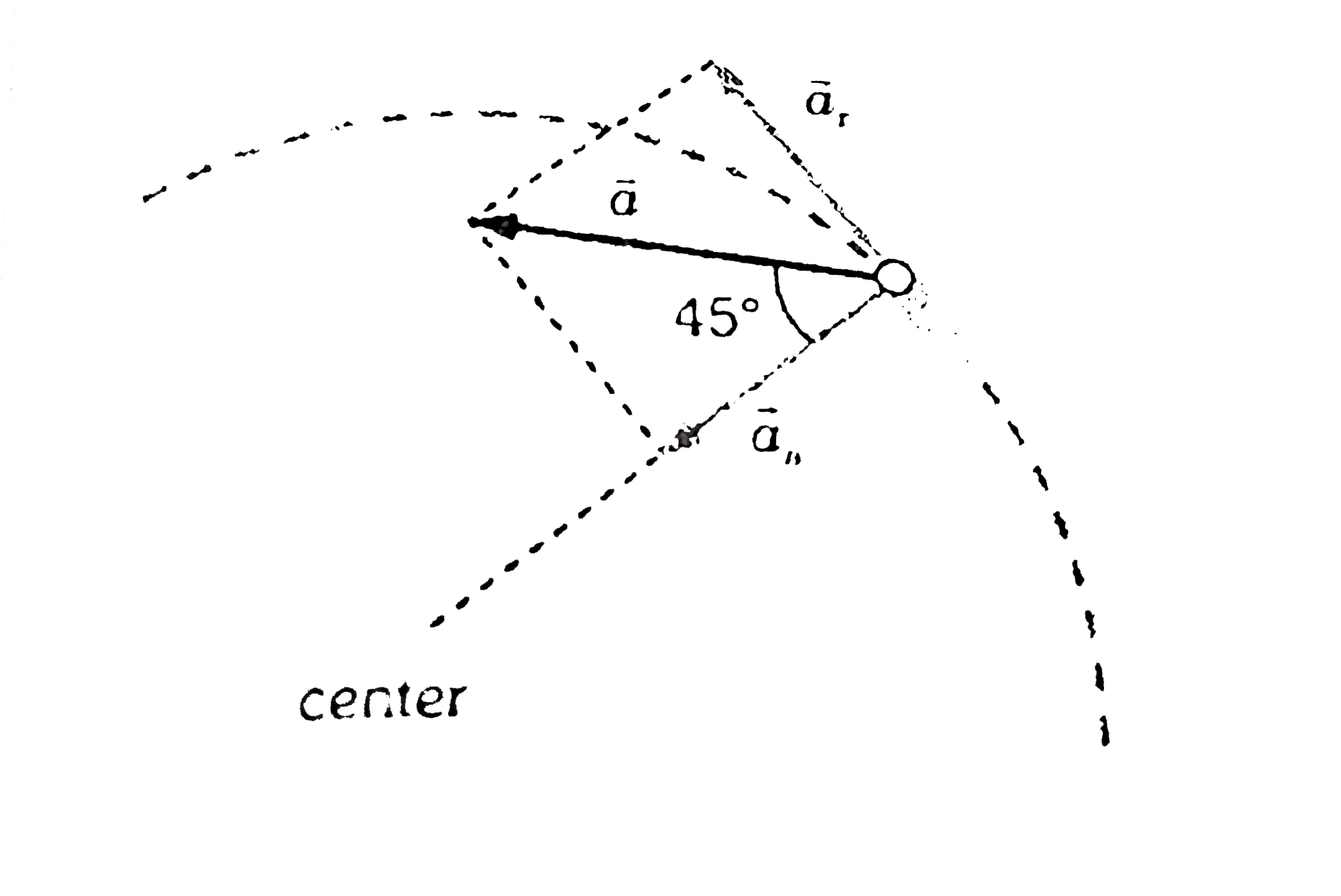A particle is moving in a circular orbit when a constant tangential acceleration. After 2s from the beginning of motion, angle between the total acceleration vector and the radius E becomes 45∘. What is the angular acceleration of the particle?

In the adjoining figure are shown the total acceleration vector →a and its components the tangential accelerations →aτ and normal acceleration →an are shown. These two components are always mutually perpendicular to each other and act along the tangent to the circle and radius respectively. Therefore, if the total acceleration vector makes an angle of 45∘ with the radius, both the tangential and the normal components must be equal in magnitudr.
Now from equation and, we have
aτ=an→αR=ω2R⇒α=ω2 ...(i)
Since angular acceleration is uniform, form equation, we have ω=ωo+αt
Substituting ω0=0 and t=2s, we have ω=2α ...(ii)
From equation (i) and (ii), we have α=0.25rad/s2
Topper's Solved these Questions
- KINEMATICSBook:ALLENChapter:KINEMATICSExercise:EXERCISE-01
Explore 55 Videos
- KINEMATICSBook:ALLENChapter:KINEMATICSExercise:EXERCISE-02
Explore 57 Videos
- ERROR AND MEASUREMENTBook:ALLENChapter:ERROR AND MEASUREMENTExercise:Part-2(Exercise-2)(B)
Explore 22 Videos
- KINEMATICS (MOTION ALONG A STRAIGHT LINE AND MOTION IN A PLANE)Book:ALLENChapter:KINEMATICS (MOTION ALONG A STRAIGHT LINE AND MOTION IN A PLANE)Exercise:BEGINNER S BOX-7
Explore 8 Videos
Similar Questions
A particle is moving in a circular orbit with a constant tangential acceleration. After a certain time t has elapsed after the beginning of motion, the between the total acceleration a and the direction along the radius r becomes equal to 45∘. What is the angular acceleration of the particle.
View SolutionIf a particle is moving with a constant velocity, what is its acceleration?
View Solution
Knowledge Check
A particle is moving in circular path with constant acceleration. In time t after the beginning of motion the direction of net acceleration is at 30∘ to the radius vector at that instant. The angular acceleration of the particle at that time t is
A3t2B1t2C√3tD√3t2A particle starts travelling on a circle with constant tangential acceleration. The angle between velocity vector and acceleration vector, at the moment when particle completes half the circular track. Is
Atan−1(2π)Btan−1(π)Ctan−1(3π)Dtan−1(2)A particle starts moving on circular path of radius 94m with tangential acceleration 3ms−2. Find angle between acceleration of the particle and radius vector at time t=1 sec.
A37∘B53∘C45∘D60∘
A point moves along a circle having a radius 20cm with a constant tangential acceleration 5cm/s2. How much time (in sec) is needed after motion begins for the normal acceleration of the point to be equal to tangential acceleration?
View SolutionA particle is moving on a circle of radius A .At an instant its speed and tangential acceleration are B and C respectively.Total acceleration of the particle at that instant is
View SolutionA point mass moves along a circle of radius R with a constant angular acceleration α. How much time is needed after motion begins for the radial acceleration of the point mass to be equal to its tangential acceleration ?
View SolutionA particle starts with constant angular acceleration of 2 rad/s2 in a circle of radius 4m. Find angle between net acceleration and radial acceleration after 2 s :-
View SolutionA point starts from rest and moves along a circular path with a constant tangential acceleration. After one rotation, the ratio of its radial acceleration to its tangential acceleration will be equal to
View Solution

